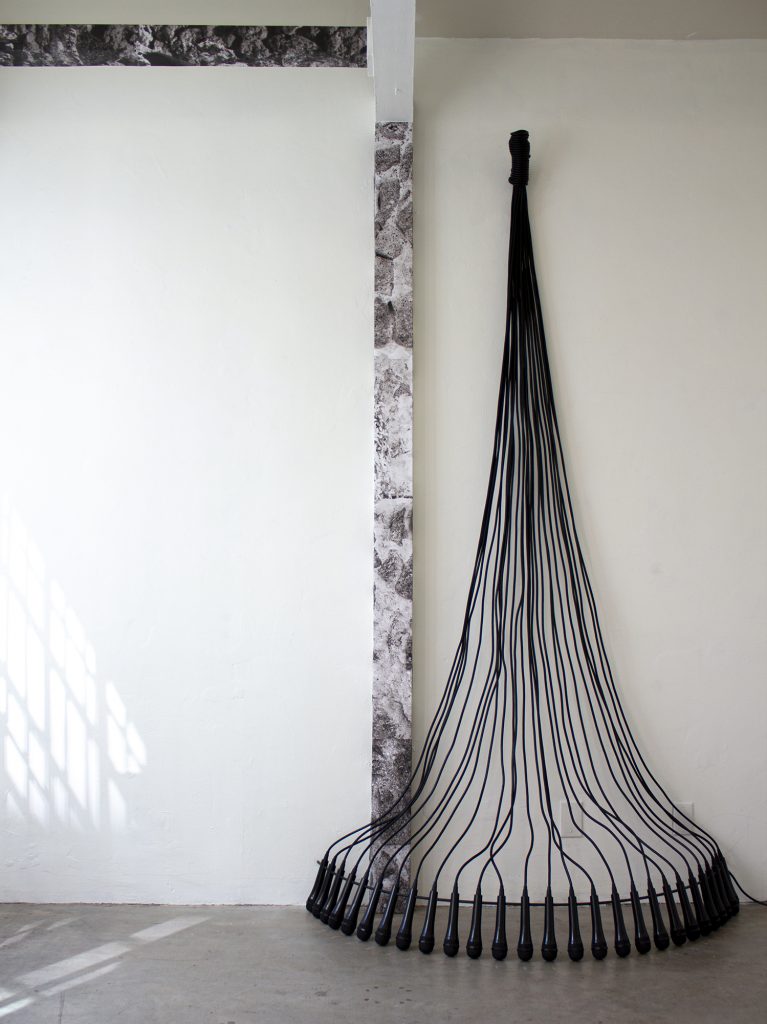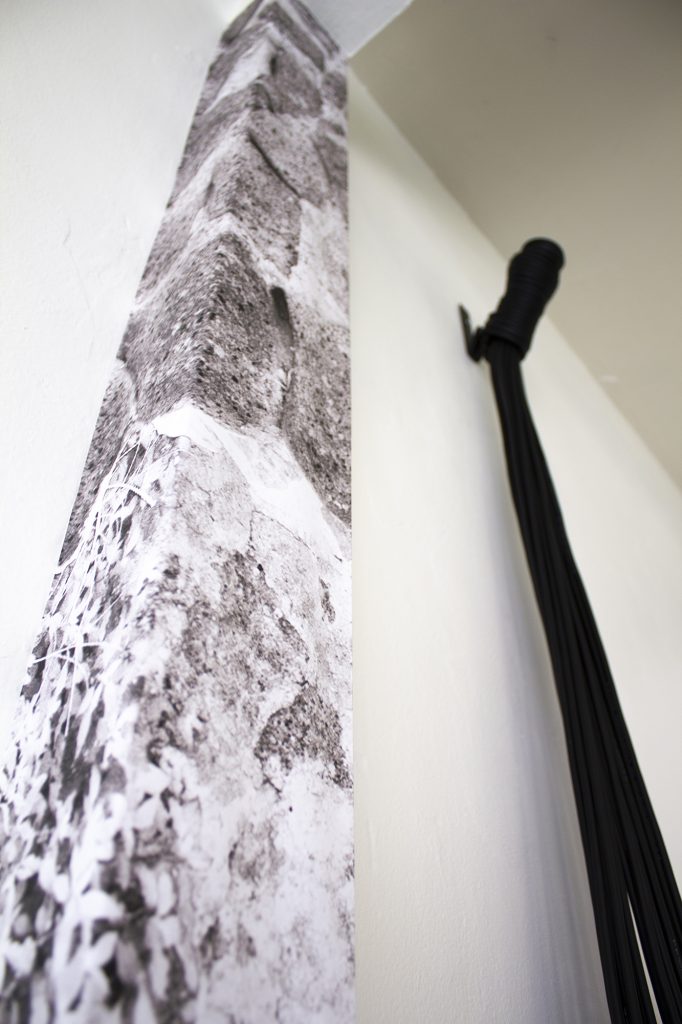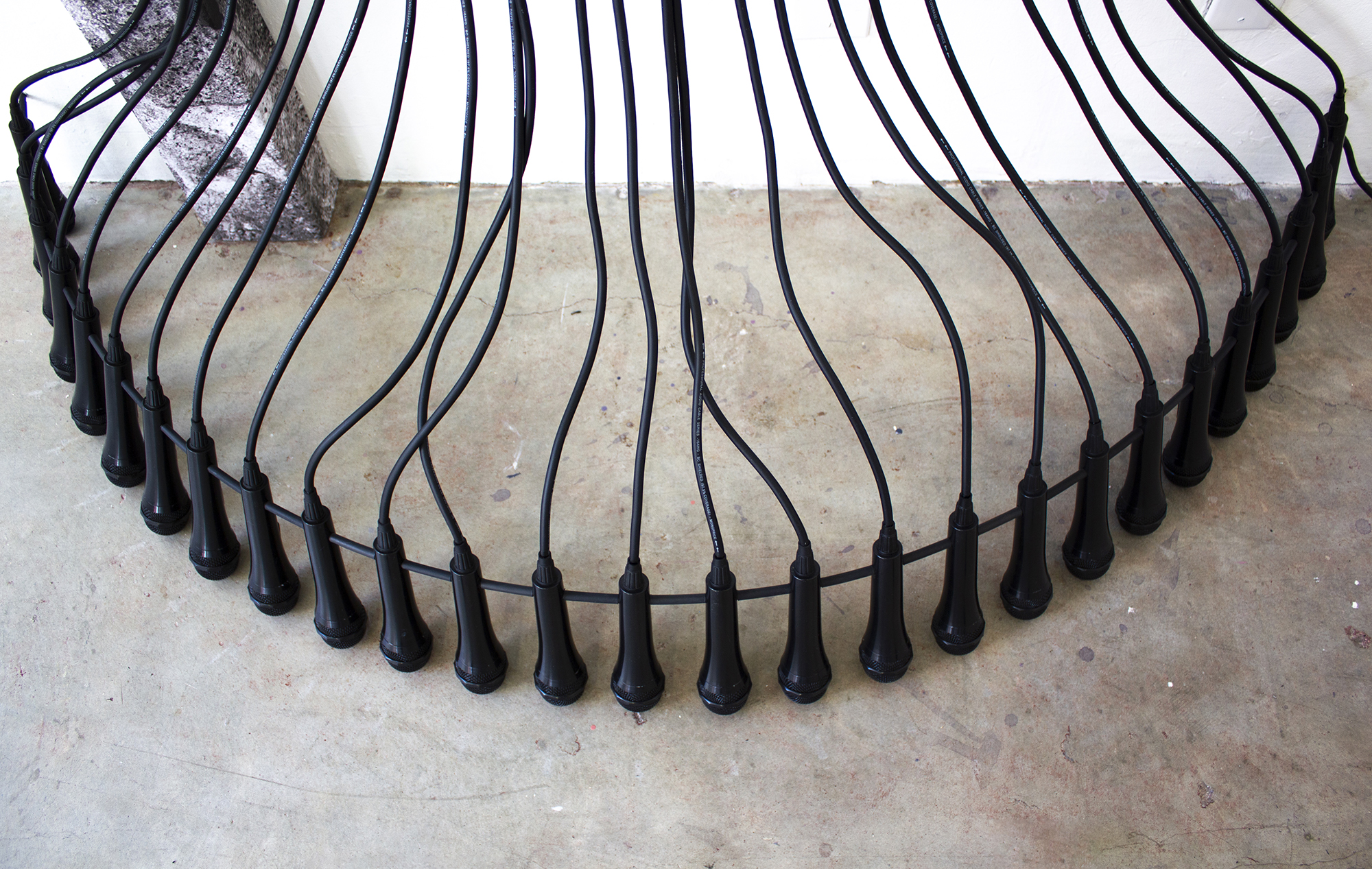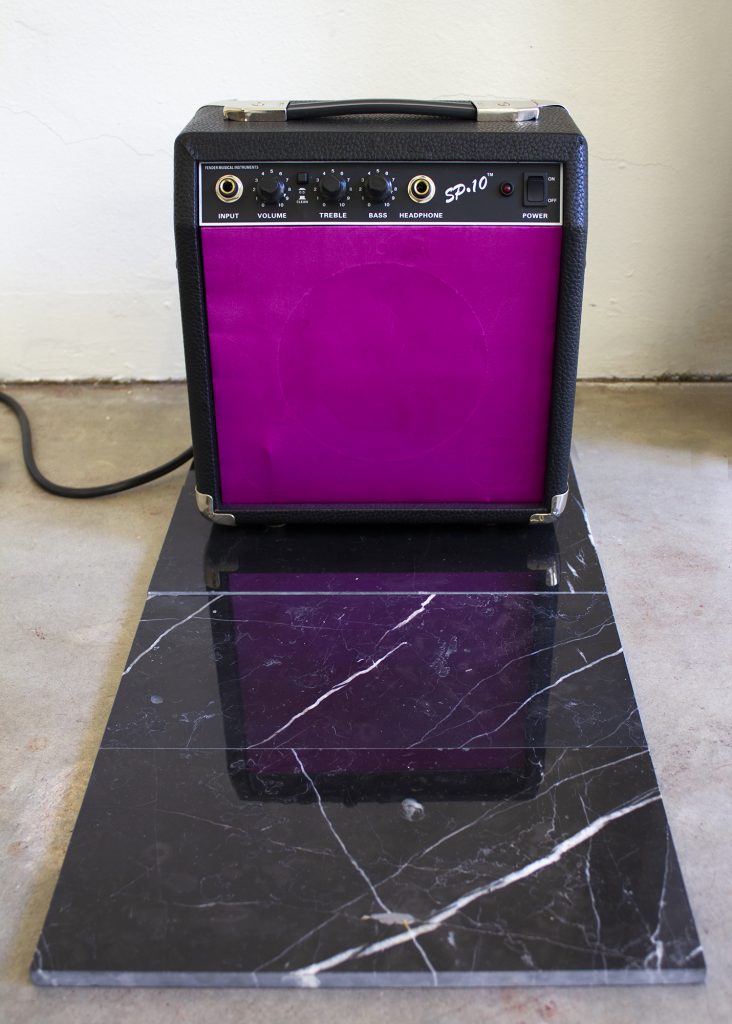Vabianna Santos: Space is Noise
On view: Feb. 13-16, 2020
Opening Reception: Thursday, Feb. 13, 6-9 pm

27 Club, 2013-2020 microphones, cables, vibrating kinetics, sound, 72 x 108 x 36 inches
Organized by Sean Noyce and Katya Usvitsky
Noysky Projects presents Space is Noise, a solo exhibition by Vabianna Santos that explores the idea of absence and theatricality through kinetic, sound-based sculpture. Inspired by the intimate space of a teenage bedroom and sound’s ability to permeate and charge otherwise invisible areas, Space is Noise imagines a human event without the body— allowing the viewer to complete the circuit with their own perceptions.
On display are a pair of automated sculptures that rattle, hum, and reverberate. They include an array of 27 lo-fi microphones, tied suggestively in a noose above the viewer; a pair of pink satin practice amplifiers positioned on a wooden stage above a pillowy floor; and a collection of plugs, cables and other trappings from a garage band, neatly arranged on the ground. These are the catalysts of rock ‘n’ roll dreams or a bedroom sing-along- not a sold-out stadium concert.
Appearing to take on life as the new agents of performance — the sculptures breathe and shake. Fluctuating between the electronic sounds of white noise and the clattering of vibrations, the objects are at once amorous and like the hiss and click of a life-support machine.
As in a live show, the rhythm from a speaker moves through the viewer and makes the heart pound, creating an awareness of the viewer’s own internal phases and connecting the body to the work. Space is Noise illuminates how the spaces between us reverberate like an echo chamber that oscillates between life and death.
More Information
On view: Feb. 13-16, 2020
Opening Reception: Thursday, Feb. 13, 6-9 pm
Exhibition hours: noon–6pm and by appointment
Public transportation: Red Line Metro to Hollywood/Highland. Walk 2 blocks east.
Parking: 2 hour validated parking at Hollywood & Highland Center: 1768 N. Highland Ave ($2); 1520 N. McCadden Pl ($7); or street parking in vicinity ($2 per hour); limited free street parking on McCadden Place between Hollywood Boulevard and Yucca Street, as well as Yucca Street between Highland Avenue and Las Palmas Avenue.
Curators: Sean Noyce and Katya Usvitsky
Artist Bio
Vabianna Santos’ work has been described as terrifying, meditative, and utterly lucid.
S(he) has exhibited and performed internationally, showing at MOCA North Miami, Vox Populi, and Headlands Center for the Arts. (He)r work has been reviewed in WhiteHot Magazine of Contemporary Art. S(he) attended the Skowhegan School of Painting and Sculpture in 2013. In 2016 s(he) attended Yaddo Artist Residency and was Artist in Residence at San Diego Art Institute. S(he) received a Master’s degree in Visual Arts from University of California San Diego (2013) and a BFA in Interdisciplinary Sculpture from Maryland Institute College of Art (2007).
Vabianna Santos’ interdisciplinary work is populated by sudden transformations, interwoven gender, mischievously updated metaphysical themes and encounters pushed out to the unthinkable. (He)r work indulges in willful contradiction, combining storytelling and performance with physical illusions. The collision of fields of color, musical instruments, architectural references, alien terrains and text invent a world of permeability between body and object. S(he) is interested in demonstrating how we live in our bodies is a vital source of knowledge.
About the work

Center: A Relic Slows Down But Never Stops, 2020, wood, velvet, amplifier handles, photographic print and carved wood, 60 x 60 x 12 1/2 inches; Left and right: Sonic Pact, 2020, satin faced amplifiers, sonic and kinetic elements, stone and cord, dimensions variable
27 Club, presents an array of microphones motorized to convulse- they are hung in an ordered arrangement just grazing the floor. The sculpture is titled for the “Forever 27 Club”: the name given to categorize the famous rock musicians who died, primarily of self-destructive means, at age 27. Using similar tactics as You Must Agree to Be With Yourself, the work is created in alliance with the viewer’s body and allows the objects themselves to perform. It cuts across the display space- at one end the microphones pointed towards the earth, at the other a line of gold-tone audio plugs- forever disconnected. The power source is hidden within a section of cable, like the top of a noose, leaving the microphones to appear deceptively self-animated.
Hey, do you know how much I want you to be empty?
The Absent Body demands the attention of the viewer. The balance between oscillating intensities within the work is insidious- finding a way into the viewer’s body, allowing the traditional performer to disappear. Physical and experiential tendencies in the work force the viewer to be attentive and receptive. Materially, it is important to pair austere and essentialized forms and textures with those items that reference popular culture and subculture. This causes the viewer to be seduced by familiarity in the face of a leaking element of doom. At the same time they are starved by the simplicity of the forms. The viewer has the strictest physical relationships to the pieces due to their arrangement, scale, configurations and presence- true interactivity can only occur upon the stage within the mind. Viewers are conditioned into a state of extreme sensitivity by the apparent stringency of the work. They are receptive, lingering on the details and emissions of the object as they wait for something (the body of the performer) that may never appear. The work demands the viewer to be porous. This allows the transmission of affect, causing the Absent Body to come into being. The performing body is sublimated into the hair standing on end on your arms or the mirage of potential- playing like a fantasy behind your eyes, but having a counterpart in real physical phenomenon and bodily reception. The Absent Body is like so much smoke or even less. The Absent Body is only the slightest of hauntings.

Detail of A Relic Slows Down But Never Stops
In A Relic Slows Down But Never Stops, the body of the performer is erased, evolving The Mediated Body into The Absent Body. The sculptural installation presents the pink-faced amplifier hooked into a replica of itself, whose treble knob is forever turning back and forth modulating the sound of white noise. The two small amps sit atop a short, faceted platform on the floor, surrounded by bed pillows. The box has been made with extreme care and wears amplifier handles on four sides. The pillows, covered in velvet, are similarly adorned with amplifier handles. The excess materiality of the additional elements has been stripped down to the essential; the smooth wood of the platform and the white cloth of the pillows are austere. Concurrently, there is still a place for sensuality within the contours of the work– surfaces are delicate or refined and convey an idiosyncratic personalization through out. The extreme care taken in presenting the amplifiers celebrates them and elevates their status.
The body in A Relic Slows Down But Never Stops is only suggested. The work “performs” in two ways. The objects and their arrangement are fashioned to imply the interaction of bodies, and a kinetic sound element draws attention to the amplifier’s “live performance.” There are places offered for bodies that will never come. Handles create the suggestion of specific interactions. The object acquires its own temporality and theatricality as it sits on display, creating in the minds of the viewer the Absent Body.
The element at the heart of A Relic Slows Down But Never Stops is sound. The amps are linked to each other through a short cable and are on at full volume. The amp on the right appears to pick up the dead signal of the amp on the left, which sits silently. The white noise that is transmitted is actually the 60-cycle hum of the space the piece is installed in- essentially what you get when there is nothing to amplify. The treble knob on the “speaking” amp moves slowly back and forth on its own, like a player piano, modulating the fuzz into a rhythmic hiss, a mechanical sigh, a breath for the technology. A relationship between this pulsating static and the beats of the human body is formed. The movement of the knob is slight, requiring the attunement of the viewer to detect it. Though no personification occurs, the amplifiers appear to enact a simple exchange that ratifies the name of our own temporal bodies- there is something amorous about their joining which at the same time resembles the hiss and click of a life-support machine.
A reminder from a friend about doom: “There is no escape from the universe.”

Pompeii / Hood Intervals, 2020, photographic print, site specific architectural intervention

Detail of 27 Club

Detail of Sonic Pact

